If you've not read Lesson 7 and the story of the man who comes home early, have a quick look now. Most of it is very easy to shoot the only complicated bit is establishing him and his half day off work.
How would you do it?
You could, of course, have a scene in the office. Maybe he says to somebody, "I'm not feeling too good. Reckon I'll take the rest of the day off." Okay, but that puts him in a negative frame of mind; I want him to go home happy, so that his later anger is stronger.
A scene where his boss says, "Stan congratulations. Salesman of the month. Take the rest of the day off." Again okay but it's adding another character and it's a little prosaic.
Can I have him exit the station, pause to check his watch against the clock on the building (his look will give me an excuse to take a close-up of the clock and see it's early)? Fairly easy to do just two shots.
Perhaps he meets a neighbour who says, "Half day, today?"
Or would it be sufficient to shoot him in high sunshine, looking pleased as he opens the garden gate?
Wow! Well that's five options and I expect you can think of another two or three.
However you decide to do it, you've got to turn the idea into pictures. So do what the professionals do and construct
A STORYBOARD
Here are the first few shots:
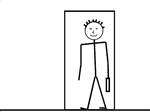 |
 |
A man emerges from a door. Posters and things will tell you it's a station. He walks cheerfully towards camera. |
| |
|
|
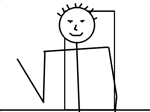 |
|
(Same shot) He walks into foreground and pauses to check his watch against the clock on the wall behind him. On his look cut to: |
| |
|
|
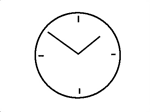 |
|
the clock! |
| |
|
|
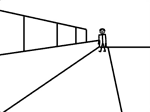 |
|
Same person comes round a corner and into VLS (Very Long Shot). He walks towards camera. |
| |
|
|
 |
|
He has a spring in his step and, as he comes closer we see he is very happy. |
| |
|
|
 |
|
The camera pans with him as he enters a gate and walks up the path. It is a nice house a happy house. |
And so on and so forth. Not a very exciting start to things no gun being fired, car chase or anything. But I think it tells the first half of the story sets the scene and introduces the character.
And simplicity is a good thing. Remember KISS?
A feature film will have a full colour, detailed storyboard; for something to be shot in ten minutes, simple black and white stick figures will do. The three things that every storyboard shows are:
- Who or what is in shot
- Size of shot
- Direction of movement or look
Here's another storyboard a full one this time with a beginning, a middle and an end. I created it after I'd watched a 'public information' film called 'Don't Litter'. It was dreadful!
But it made me think about how to create something that shows the inadvisability in a non-preachy sort of way. Not brilliant, but okay for a short piece:
Lack of drawing skill doesn't matter at all; just look at the examples here! But note that, although the drawings are rubbish, you can always tell which character is which. One has hair, one has none, another has glasses, whatever.
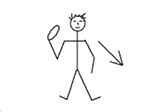 |
 |
Loutish sort of person walking along peeling a banana.
(The arrow indicates the direction of walk.) |
| |
|
|
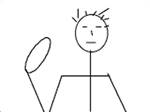 |
|
(Same shot he's just come closer.)
He glances quickly around; no bin. So he chucks the skin over his shoulder. |
| |
|
|
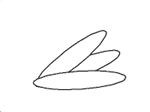 |
|
The skin lands splat on the ground.
|
| |
|
|
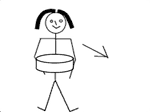 |
|
Approaching from the same direction comes a little old lady carrying a cake (or other desirable depending on the age, etc, of the litterer).
She comes closer (same shot): |
| |
|
|
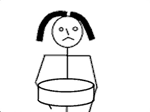 |
|
She spots the offending skin. (A shot of it here? Maybe.) She looks up at the offender then calls out: "Hey". |
| |
|
|
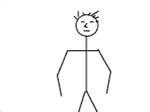 |
|
Litterer turns with a 'You talking to me?' sort of attitude
|
| |
|
|
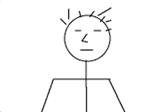 |
|
(Same shot)
walks forward threateningly. Then he sees: |
| |
|
|
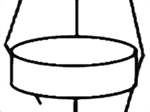 |
|
The cake, bottle of whisky, whatever. |
| |
|
|
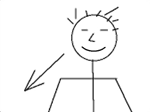 |
|
He completely misunderstands. Thinks it's for him! Eyes only for the cake, he heads for it. But meets
|
| |
|
|
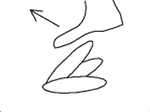 |
|
the banana skin
|
| |
|
|
 |
|
with the expected result. Whoops! |
| |
|
|
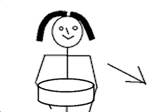 |
|
The cake bearer isn't too dismayed.
She moves forward. |
| |
|
|
 |
|
The litterer rubs his head. Ouch. A foot appears, then a hand takes the banana skin and exits left. |
| |
|
|
 |
|
The feet and hands belong to the 'little old lady'. She says, "Save the environment
and save yourself a headache. Don't litter". Skin goes into
|
| |
|
|
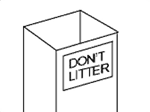 |
|
the bin with the message on it. |
By the way, don't demand that your performer
actually trips over and smashes his head on the
ground! All the litterbug has to do is to yell
and drop down to a crouch. The cut to the cake
lady will cover any continuity problem.
Here's the result:
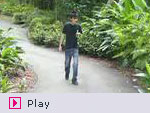
LitterShow
It's close to, but not exactly the same as the storyboard. On location (and editing) things change. For one thing, the sound was pretty empty I decided to add music.
Things will change but edit what you shoot, not what you intended to shoot!
Doing a storyboard can save a lot of time. It's a huge help in planning, and if you keep it with you on the shoot it can remind you of shots you might otherwise forget in all the complexities of shooting. Ten minutes with a pencil and paper versus going all the way back to the location again tomorrow to do that one critical shot you forgot. Especially if it's now raining!
After a while you don't even need the pencil and paper; you'll find you're doing the storyboard in your head.
Until then, though, you might find a blank storyboard useful:
 Download blank storyboard Download blank storyboard
|
